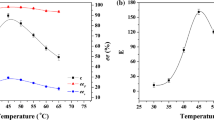Abstract
The hydrolysis of racemic butyl 2-(4-substituted phenoxy)propionates having various substituents catalyzed by lipase MY from Candida rugosa was achieved in di-isopropyl ether containing 0.75% (v/v) of 2.4 M LiCl or 1.2 M MgCl2 aqueous solution. Water molecules hydrated to the metal ion in isopropyl ether acted as a nucleophile to cause the hydrolysis of these esters as with water alone. Metal ions used significantly enhanced their enantioselectivities by 100-fold or above, as compared with the ordinary reaction media.
Similar content being viewed by others
References
Chen C-S, Fujimoto Y, Girdaukas G, Sih CJ (1982) Quantitive analyses of biochemical kinetic resolutions of enantiomers. J. Am. Chem. Soc. 104: 7294–7299.
Kawashima Y, Hamioka N, Kozuka H (1984) Introduction of microsomal stearoyl-CoA desaturase by the administration of various phenylacetic acid derivatives. J. Pharmacobio-Dynamics 7: 286–293.
Klibanov AM (1990) Assymetric transformations catalyzed by enzymes in organic solvents. Acc. Chem. Res. 23: 114–120.
Okamoto T, Ueji S (1999) Drastic enhancement of the enantioselectivity of lipase-catalysed esterification in organic solvents by the addition of metal ions. Chem. Commun. 10: 939–940.
Santaniello E, Ferraboschi P, Grisenti P, Manzocchi A (1992) The biocatalytic approach to the preparation of enantiomerically pure chiral building blocks. Chem. Rev. 92: 1071–1140.
Ueji S, Watanabe K, Koshiba T, Nakamura M, Oh-ishi K, Yasufuku Y, Miyazawa T (1999) Lipase-catalyzed esterification of 2-(4-substituted phenoxy)propionic acid in organic solvents: substituent effect controlling enantioselectivity toward racemic acids. Biotechnol. Lett. 21: 865–868.
Witiac DT, Ho TC-L, Hackney RE, Connor WE (1968) Hypocholesterolemic agents. Compounds related to ethyl _-(4-chlorophenoxy)-_-methylpropionate. J. Med. Chem. 11: 1086–1089.
Yasufuku Y, Ueji S (1995) Effect of temperature on lipase-catalyzed esterification in organic solvent. Biotechnol. Lett. 17: 1311–1316.
Yasufuku Y, Ueji S (1997) High temperature-induced high enantioselectivity of lipase for esterification of 2-phenoxypropionic acids in organic solvent. Bioorg. Chem. 25: 88–89.
Author information
Authors and Affiliations
Rights and permissions
About this article
Cite this article
Okamoto, T., Ueji, S. A new method for improving the enantioselectivity of lipase-catalyzed hydrolysis in organic solvent containing a small amount of water in the presence of metal ions. Biotechnology Letters 22, 1169–1171 (2000). https://doi.org/10.1023/A:1005637329704
Issue Date:
DOI: https://doi.org/10.1023/A:1005637329704




